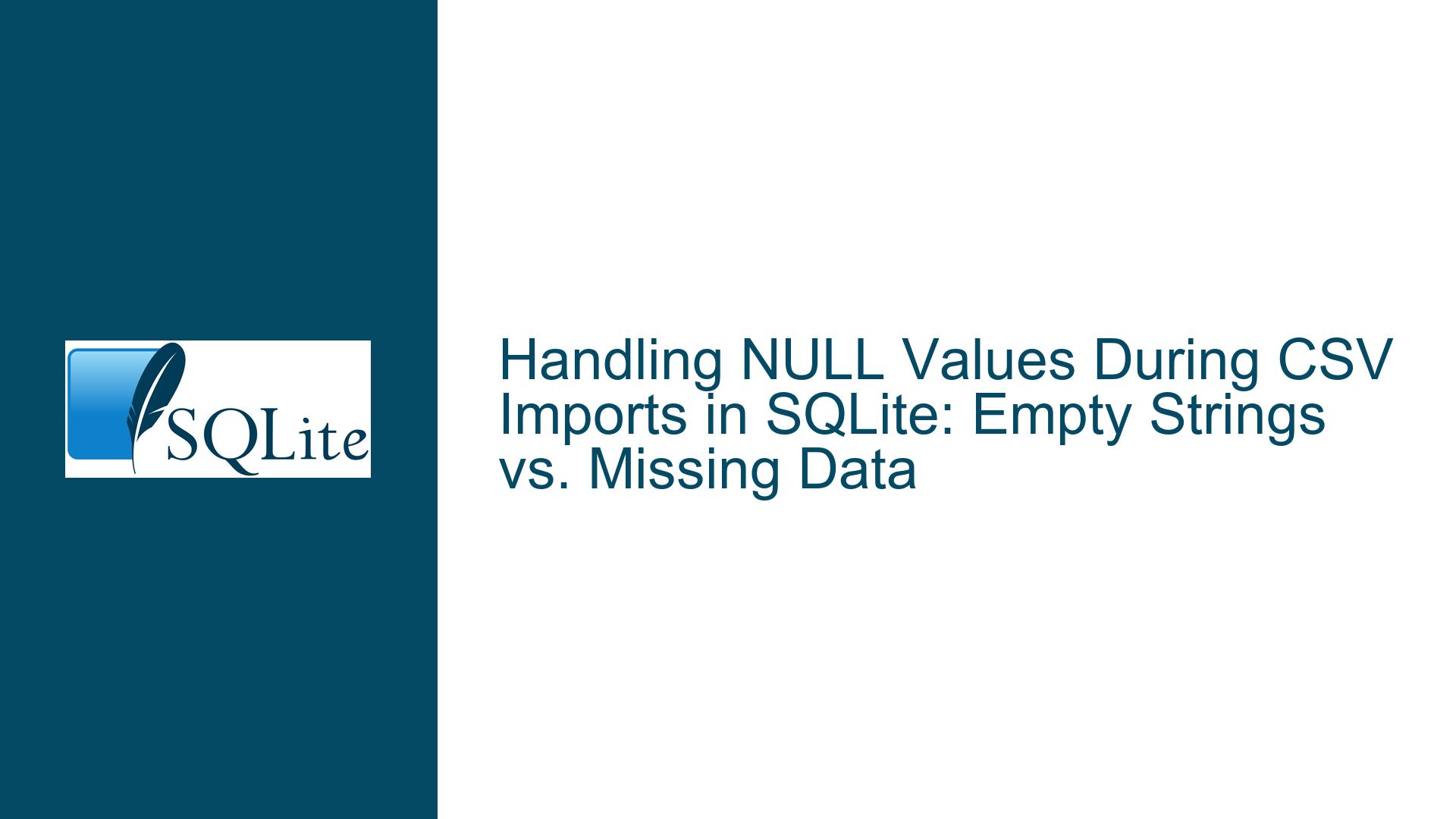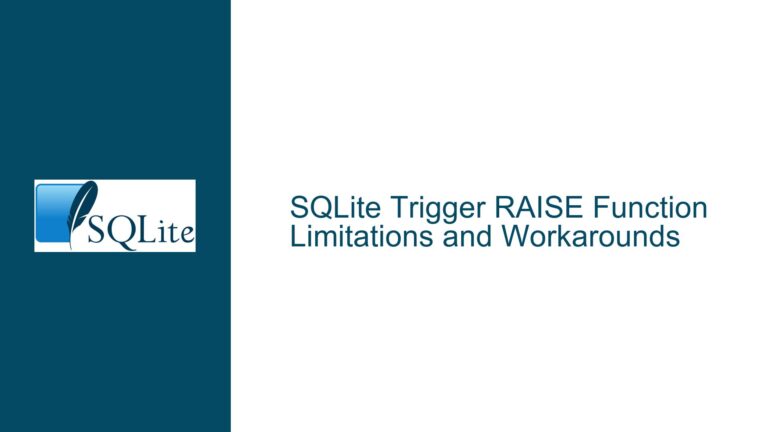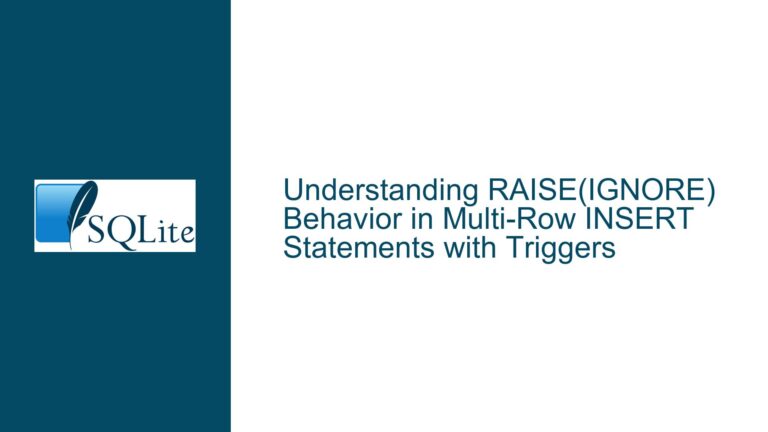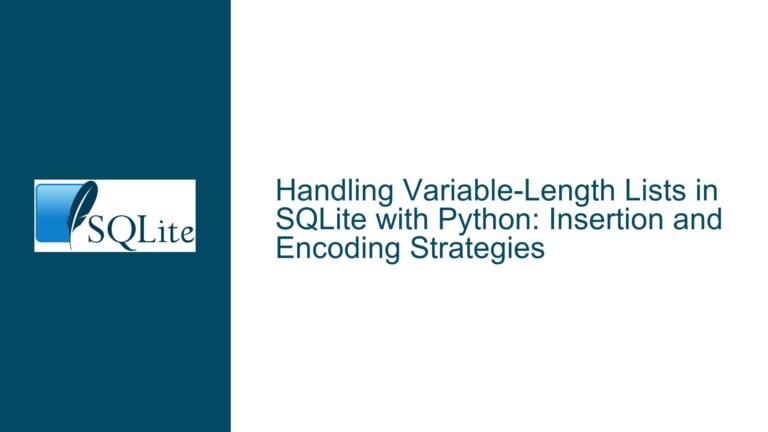Handling NULL Values During CSV Imports in SQLite: Empty Strings vs. Missing Data
Issue Overview: NULL Values Misinterpreted as Empty Strings During CSV Import
The core challenge revolves around SQLite’s .import command misinterpreting empty fields in CSV files as empty strings ('') instead of NULL values. This behavior creates conflicts when importing data into tables with strict column constraints. For example:
- A
NUMERICcolumn configured to acceptNULLwill reject empty strings, forcing implicit type conversions (e.g.,''→0), which distorts data integrity. - A
TEXTcolumn with aNOT NULLconstraint will fail to import if empty strings are provided, even if the field is intentionally left blank (i.e., represents missing data).
The absence of a native mechanism to map empty CSV fields to NULL forces users into post-import cleanup workflows, such as running UPDATE statements to replace empty strings with NULL. This adds complexity, especially when handling large datasets where .import’s performance advantages over raw INSERT statements are critical.
The debate centers on CSV’s inherent limitations: the format lacks a standardized way to represent NULL values. While RFC 4180 defines CSV syntax, it does not address missing data semantics. SQLite’s current implementation defaults to treating unquoted empty fields as empty strings, which aligns with CSV’s literal interpretation but clashes with relational database expectations where NULL signifies absence. This mismatch becomes acute in mixed-type columns (e.g., TEXT fields that permit NULL but reject empty strings for business logic reasons).
Possible Causes: CSV Format Ambiguity and Import Logic Limitations
1. CSV Format Lacks Native NULL Representation
CSV files store data as plain text, with fields separated by delimiters (commas). The format does not reserve a specific token for NULL. Empty fields (e.g., ,, in a row) are ambiguous: they could represent missing data (NULL), intentional empty strings (''), or even placeholders for default values. SQLite’s .import command resolves this ambiguity by treating empty fields as empty strings, a decision rooted in CSV’s text-centric nature.
2. SQLite’s .import Command Does Not Support Custom NULL Mapping
Unlike SQLite’s .nullvalue command (which controls how NULL is displayed during export), there is no equivalent option for imports. The .import command processes CSV fields verbatim, with no built-in logic to transform empty strings into NULLs. This creates a disconnect between data ingestion and storage semantics, particularly when importing into tables with strict constraints.
3. Implicit Type Conversion Conflicts
When empty strings are imported into NUMERIC or INTEGER columns, SQLite attempts automatic type conversion, coercing '' to 0. This violates the principle of least astonishment: users expect missing data to remain NULL, not morph into default values. For example, importing a CSV with an empty salary field into a NUMERIC column would erroneously store 0, skewing aggregate calculations like AVG(salary).
4. Schema Constraints and Business Logic Mismatches
Tables often enforce constraints that assume NULL for optional fields. For instance, a users table might have a birthdate column defined as TEXT CHECK (birthdate IS NULL OR date(birthdate) IS NOT NULL). An empty string imported into this column would trigger a constraint violation, even though the intent was to leave the birthdate unspecified.
Troubleshooting Steps, Solutions & Fixes: Bridging the CSV-NULL Gap
1. Pre-Import Data Transformation
a. Preprocess the CSV File
Modify the CSV before importing to replace empty fields with a placeholder that SQLite recognizes as NULL. For example, use sed or Python to substitute ,, with ,\\N,:
sed 's/,,/,\\N,/g' input.csv > output.csv
In SQLite, set .nullvalue \\N before importing. This converts \N to NULL during ingestion.
b. Use Scripting Languages for Controlled Imports
Leverage Python’s csv module or Pandas to read the CSV, replace empty strings with None (which maps to SQLite NULL), and write the data via parameterized queries:
import sqlite3
import csv
conn = sqlite3.connect('database.db')
cursor = conn.cursor()
with open('data.csv', 'r') as f:
reader = csv.reader(f)
for row in reader:
row = [None if field == '' else field for field in row]
cursor.execute('INSERT INTO table VALUES (?, ?, ?)', row)
conn.commit()
2. Post-Import Data Cleansing
a. Use a Staging Table
Import the CSV into a temporary table with relaxed constraints, then transform the data into the target schema:
-- Create staging table with TEXT columns to accept raw data
CREATE TABLE staging (id TEXT, name TEXT, salary TEXT);
-- Import CSV
.import --csv data.csv staging
-- Transform and load into target table
INSERT INTO employees (id, name, salary)
SELECT
id,
name,
CASE WHEN salary = '' THEN NULL ELSE CAST(salary AS REAL) END
FROM staging;
b. Batch UPDATE Statements
After importing, replace empty strings with NULL in nullable columns:
UPDATE table SET column1 = NULL WHERE column1 = '';
For large datasets, wrap this in a transaction to improve performance:
BEGIN TRANSACTION;
UPDATE table SET column1 = NULL WHERE column1 = '';
COMMIT;
3. Leveraging SQLite Extensions and Virtual Tables
a. Use the sqlite3vsv Extension
Keith Medcalf’s sqlite3vsv.c extension introduces a virtual table that interprets CSV files with customizable NULL handling:
-- Load extension (compile separately if needed)
.load ./sqlite3vsv
-- Create virtual table mapping empty fields to NULL
CREATE VIRTUAL TABLE temp.csv_data USING vsv(
filename='data.csv',
header=ON,
nulls=ON
);
-- Query or insert into target table
INSERT INTO main.table SELECT * FROM temp.csv_data;
The nulls=ON option treats empty CSV fields as NULL.
b. SQLite’s CSV Virtual Table (Experimental)
Enable the CSV virtual table using the -DSQLITE_ENABLE_CSV compile-time flag, then define a virtual table with explicit NULL handling:
CREATE VIRTUAL TABLE temp.csv_data USING csv(
data='id,name,salary\n1,Alice,\n2,Bob,75000',
header=YES,
nulls=YES
);
4. Custom Builds and Patches
For advanced users, modify SQLite’s source code to add a .nullimport command. In the shell.c file, extend the import command logic to replace empty strings with NULL when a flag is set:
// Hypothetical patch to handle NULLs during import
if( p->nullImport ) {
for(int i=0; i<nCol; i++){
if( azCol[i][0] == '\0' ){
azCol[i] = NULL;
}
}
}
Recompile SQLite with this patch to enable --nullimport during .import.
5. Adopting Alternative Data Formats
If CSV’s limitations are prohibitive, switch to formats with explicit NULL support:
- JSON: Use
json1extension to import nested data.
INSERT INTO table SELECT
json_extract(value, '$.id'),
json_extract(value, '$.name'),
json_extract(value, '$.salary')
FROM json_each(readfile('data.json'));
- SQLite Archives: Export/import using
.archivefor binary-accurate data transfer.
6. ETL Best Practices
Implement a formal Extract-Transform-Load (ETL) pipeline:
- Extract: Import raw CSV into a staging table.
- Transform: Validate, cleanse, and convert data using SQL queries.
- Load: Insert transformed data into production tables with constraints.
Example transformation step:
-- Handle NULLs, trim whitespace, validate dates
INSERT INTO production (id, event_date, notes)
SELECT
id,
CASE
WHEN event_date = '' THEN NULL
ELSE date(event_date)
END,
TRIM(notes)
FROM staging
WHERE event_date IS NULL OR date(event_date) IS NOT NULL;
By combining preprocessing, post-import updates, extensions, and ETL strategies, users can effectively bridge the gap between CSV’s empty fields and SQLite’s NULL semantics. Each approach balances automation, performance, and data integrity, allowing flexibility based on workflow requirements.






